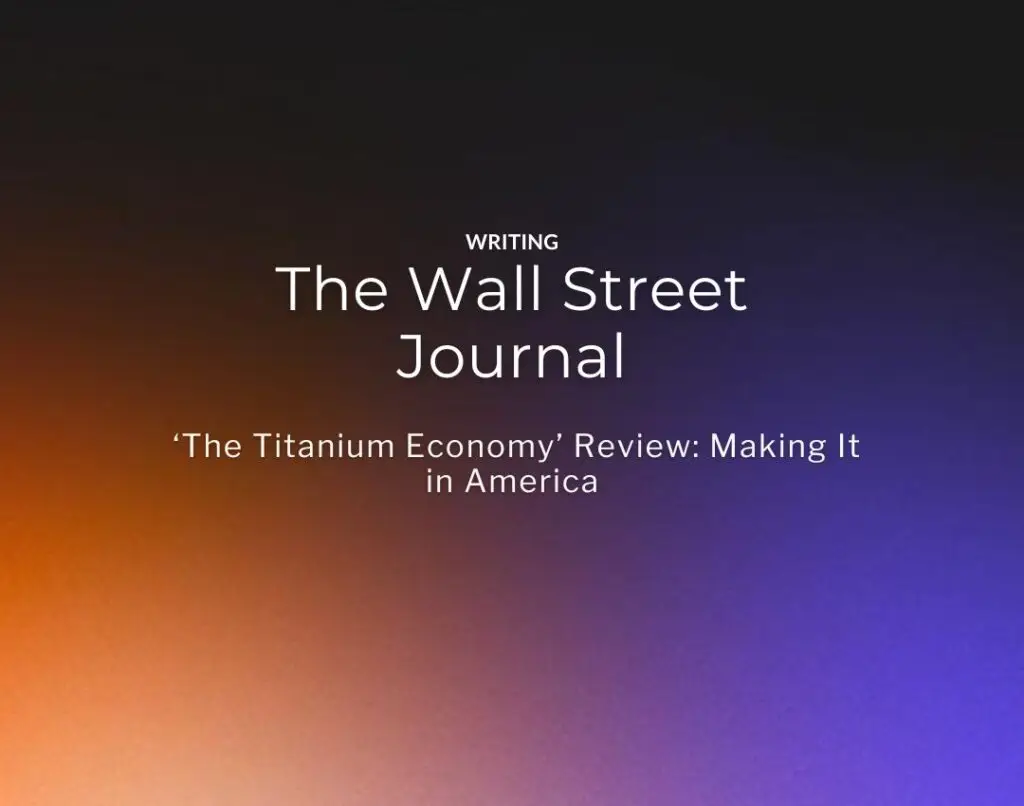Supply-chain issues are about more than keeping shelves stocked. ‘The American spirit,’ the authors remind us, ‘is about controlling one’s destiny.’
By Geoffrey Cain
Oct. 12, 2022

After many grueling nights designing and building a car in “makeshift tents,” Elon Musk emerged with a prescient lesson for Tesla. “The issue is not about coming up with a car design���it’s absolutely about the production system,” Mr. Musk said in 2019, during the unveiling of the car maker’s SUV, the Model Y. “You want to have a good product to build, but that’s basically the easy part. The factory is the hard part.”
Mr. Musk wanted to take vertical integration—or control over the supply chain—to what he’s since called “absurd” heights. His business philosophy was decisive. In February 2022, the federal government announced that supply-chain issues meant that American manufacturers had five days’ worth of chips in their inventories—an emergency shortage compared to their 40-day supplies three years earlier.
The disaster speaks to the need to rebuild manufacturing at home, argue co-authors Asutosh Padhi, Gaurav Batra and Nick Santhanam in their fluid, digestible and timely book, “The Titanium Economy: How Industrial Technology Can Create a Better, Faster, Stronger America.” The book’s premise is that “we are capable of producing a thousand companies akin to Tesla in every industry.” The authors write: “Part of what Musk understood—something that has also been embraced by other industrial leaders—is that the core of the American spirit is about controlling one’s destiny.”
Messrs. Padhi, Batra and Santhanam, all current or former McKinsey executives, come from engineering and management backgrounds that give them authority in the field of “industrial technology”—the catchall term for manufacturing, robotics and hardware production. Despite being white-collar consultants, they’ve helped run factory floors, an area not normally associated with McKinsey. Mr. Santhanam, a chemical engineer, came of age as a professional during the dot-com boom, but preferred working with hardware he could touch, later advising semiconductor manufacturers as a McKinsey consultant. Mr. Batra once worked at a consumer-goods plant in India, where a rural town of 20,000 “was supported by the plant.” Mr. Padhi worked for industrial companies in Cleveland, where stoic workers innovated without talking about it, unlike in Silicon Valley, which he saw as a land full of talk.
With more companies reshoring their factories from China and elsewhere, the authors argue that American manufacturing is propelling a social and economic force they call the Great Amplification Cycle. Factories set up shop in small American towns, workers learn new skills and take home better paychecks, buying homes and upgrading their lives. Over time, more talented people show up looking for a better quality of life, opening businesses, injecting capital and contributing to local culture.
The authors glide through a succession of breezy anecdotes about 3-D printing, advanced materials and artificial intelligence as applied to manufacturing, and point out that some industrial-technology firms rival the returns of Facebook and Amazon. Yet the sector attracts less than 1% of venture capital. Trex, a Virginia-based company that uses advanced robotics to recycle plastic bags into construction material, has seen its share price increase by nearly 5,000% in the past decade. With its two factories connected through advanced software, Trex is an example of a successful company replacing the older, static model of the central factory.
“The Titanium Economy” is best when it brings us outside the superstar cities of Silicon Valley and New York and into prosperous manufacturing hubs in South Carolina, Texas and Indiana. The authors write that “for every Flint, Michigan, that has been infamously devastated by the loss of jobs in the automotive industry, there’s a Simpsonville, South Carolina.” In the 1970s, Michelin opened a tire plant in Simpsonville, home to 25,000 people, and helped train workers. Since the 1980s, the auto maker BMW, the aerospace firm Collins and numerous other firms have showed up and hired the area’s skilled workforce.
Replete with stories of bonanza and fortune, “The Titanium Economy” at times sounds too good to be true, like a McKinsey brochure for clients and investors. Indeed, the authors’ McKinsey affiliations sometimes seem to dampen their ability to question the companies they cover. “In terms of governance, diverse board compositions, higher analyst coverage, and changing shares of low-turnover investor profiles all contribute to multiple expansion,” the authors write in a cryptic passage. Meanwhile, the ability to explain the market to investors, they add, is “an area where many industrial companies still fall short.”
The reluctance to criticize extends to countries where McKinsey has a strong presence. The authors write that the Chinese government is “dedicated to taking the lead” by providing state funds for critical industries. But they never mention that the country, which imports more chips than ever, remains generations behind the American semiconductor industry and is far from its vision of self-sufficiency.
The U.S. government should be more involved with a national industrial strategy, the authors argue. But they gloss over the transformations already under way. They never mention the CHIPS and Science Act, signed into law in August, which includes $52.7 billion in subsidies to U.S. semiconductor production. Intel CEO Pat Gelsinger called it potentially “the most important piece of industrial policy” since World War II.
This is merely one shift in how American business leaders view homegrown industry. Nevertheless, “The Titanium Economy” is an enjoyable read about an overlooked and underappreciated field and its most successful companies. The timing is right. Americans are waking up to the importance of building resilience at home, rather than outsourcing for an easy price cut.
Mr. Cain is a senior fellow at the Lincoln Network and the author of two books on technology and industry.
Appeared in the October 13, 2022, print edition as ‘Making It In America‘.
See Also:





